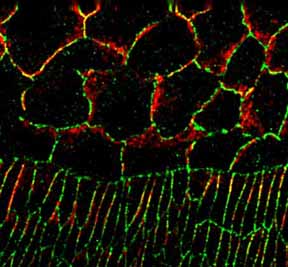Don Fox | 2001 – 2006
 Ph.D. student in Biology
Ph.D. student in Biology
Regulating adhesion during morphogenesis
During animal development, cells undergo coordinated changes in shape and position. This process of morphogenesis requires cell-cell and cell-cell matrix junctions as well as the actin cytoskeleton. In epithelial cells, the major sites of cell-cell contact are adherens junctions (AJs), a multi-protein complex that links the cytoskeleton of adjacent cells. While the key components that make up AJs are known, the signals that regulate the assembly and disassembly of this complex and its connection to the cytoskeleton are poorly understood. Recently, we have focused our attention on the roles of several candidate AJ regulators.
One potential regulator, the non-receptor tyrosine kinase Abelson (Abl), is required for stable assembly of the AJ during embryogenesis. By examining syncytial and cellular blastoderm stage embryos devoid of Abl, we found that Abl appears to control the balance of actin regulators (e.g. Enabled, Ena) localized to different cellular sites, with particular effects on the apical region of the cell, where AJ proteins are located. However, as these stages of development do not require AJ function, we are now focusing our attention on the requirements of Abl function during the AJ-dependent processes of embryonic morphogenesis. We are using the cold-sensitivity of abl mutants to evaluate the full requirement of Abl at these stages and to elucidate its mechanism of action. In parallel, we are examining the localization of Abl during embryogenesis to identify where Abl may be active.
We have also focused our attention on two proteins known to regulate AJs in cultured cells: the catenin p120, and the small GTPase Rho. In flies, we have found both p120 and Rho1 mutants to genetically interact with mutants in shotgun, which encodes Drosophila E-cadherin. Currently, we are investigating the means by which these proteins regulate AJs during embryonic morphogenesis. Additionally, we are testing the hypothesis that p120 inhibits Rho. These studies will help to clarify how Rho may regulate AJs in vivo and to address whether this regulation is dependent on p120.
Publications
- Stevens, T L., Rogers, E M., Koontz, L. M. , Fox, D. T., Homem, C. C.F., Nowotarski, S. H., Artabazon, N. B., and Peifer, M. (2008). Using Bcr-Abl to examine mechanisms by which Abl kinase regulates morphogenesis in Drosophila. Molecular Biology of the Cell 19, 378-393.
- Fox, D.T., and Peifer, M. (2007). Abelson kinase and RhoGEF2 regulate actin organization during cell constriction in Drosophila. Development 143, 567-578.
- Fox, D.T.,and Peifer, M. (2007). Cell adhesion: Separation of p120’s powers? Current Biology 17, R24-R27.
- Fox, D.T., Homem, C.C.F., Myster, S.H., Wang, F., Bain, E.E., and Peifer, M. (2005). Rho1 Regulates Drosophila Adherens Junctions Independently of p120ctn. Development 132, 4819-4831.
- Grevengoed E.E., Fox D.T., Gates J., Peifer, M. (2003). Balancing different types of actin polymerization at distinct sites: Roles for Abelson kinase and Enabled. Journal of Cell Biology, 163, 1267-1280.
- Myster, S.H.,, Cavallo, R., Anderson, C.T., Fox, D.T.. and Peifer, M. (2003). Drosophila p120catenin plays a supporting role in cell adhesion but is not an essential adherens junction component. Journal of Cell Biology160 433-449.


